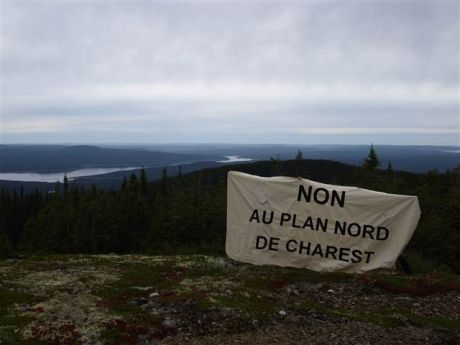Features
You are here
Jean Charest's plan to wreck the North

March 26, 2012
Following the historic 200,000-strong march of students and allies in Montreal on March 22, Quebec student leader Gabriel Nadeau-Dubois called Jean Charest’s “Plan nord” a “Plan Nord of shit,” and he’s right.
This is an old, familiar story: exploitation of natural resources and aboriginal lands by mining interests, under the pretense of consultation, economic development, and protection. But Jean Charest’s Plan Nord is stupendous for its scale, for the level of government involvement, and for its influence on other governments in Canada.
The project is laid out as a twenty-five year plan that will see government and corporate investment combined to the tune of $80 billion. In its first five years, announced in last year’s budget, $1.2 billion will be spent on infrastructure—extending highways and other transportation corridors as well as telecommunications and feasibility studies for a deep-water port in Whapmagoostui-Kuujjuarapik. The plan will also put more than $2 billion into a gigantic slush fund for the Plan’s future development. Even that is not enough for some corporate interests, which have started pressuring the government to absorb costs associated with connecting to the Hydro-Quebec network.
The plan covers 72 per cent of Quebec’s geographic area, 1.2 million square kilometers. This includes James Bay, Nunavik and the North Shore—an area twice the size of France. Charest is pinning his hopes for support for both Plan Nord and for his re-election on the claim that the plan will create 20,000 jobs. He also claims it will include designating 50 per cent of the territory as protected.
The backdrop of Charest’s plan is the collapse of Quebec’s natural resources industries. Charest is desperate to save Quebec’s economy, and he’ll do anything to keep the corporations happy. He’s already taken several trips abroad to promote it, most recently to the European Union, where he presented to potential investors and met with government officials. Meanwhile, at hearings back home in Montreal, Charest’s Environment Minister, Pierre Arcand, suggested that mining would not be forbidden on the 50 per cent supposedly intended for protection.
Charest and his government have already embarked on a massive charm operation, at the taxpayers’ expense, with a tour of Québec’s regional chambers of commerce and an expensive ad campaign.
Opposition
Significant social forces are already arrayed against the plan. The Conféderation des syndicats nationaux (CSN), Quebec’s second largest union, has expressed its severe concerns about the plan’s ability to protect that 50 per cent, when no controls are in place to ensure exploitation of the other 50 per cent will not hurt the entire region.
Nature Quebec, Greenpeace, and many other environmental groups are extremely skeptical of the time lines and the feasibility of the incremental increases in protected territory supposedly part of Plan Nord, when the government does not consider deforestation an industrial activity (only 10 per cent of forests are to be protected), and plans to establish infrastructure and allow exploration and tourism in supposedly protected areas.
First Nations groups have also expressed concerns about the impact of industrial development. The Inuit, the Innu, the Cree, the Naskapis of Schefferville, the Algonquin, and the Atikamekw, all have grave misgivings.
Plan Nord is, more than anything else, a giant appeal for corporate investment. It has been on the drawing board since the last Quebec election. There are no guarantees that it will work even for the interests of those for whom it was created: big mining, big energy, and big exploiters.
Resistance has been significant, though scattered. In one recent example, on March 5, Innu activists blockaded highway 138 in protest of the La Romaine Hydroelectric Complex megaproject in their traditional territory. The Romaine river is one of the few major rivers in Québec still free from hydro dams. Mohawk and other allies protested in Montreal in solidarity. The project has been linked to Plan Nord. The blockade was shut down after a week. “We had the Arab Spring, I think we’re now seeing an Innu Spring,” said a spokesperson from the Alliance Romaine (a coalition established to protect the Romaine river), supporting the Innu. The blockade followed a similar blockade of route 167 by Cree activists in January. Sections of the Cree have agreed to support the Plan with some conditions, but many still oppose it.
So far, much of the rest of the opposition to Plan Nord has been in the form of lobbying and media communications.
Earth Day
That will all change on Earth day, April 22, 2012. On that day Charest will meet with business leaders interested in cashing in on Plan Nord. Marches will start at 2 pm in cities across Quebec, timed to coincide with the start of Charest’s summit in Montreal.
The summit could be the launching pad for the Liberal’s election campaign, attempting to win a fourth election in 10 years in spite of dissatisfaction rates having remained at a steady 70 per cent for several months.
On the same weekend, la Coalition avenir Québec (CAQ) will hold its founding convention. The environment was absent in the initial policy statements of CAQ and it supports both the exploitation of the North and the tuition fee increase that provoked the ongoing student strike. Charest’s strategy seems to be an attempt at uniting the right and repolarizing the political scene between his Liberals and their old adversary, Marois’ Parti Québécois.
The organizers of Earth Day in Quebec, which include dozens of environmental groups, church leaders, artists and other social movement leaders, have made the North a key element. The news about Plan Nord is getting out to the mass of ordinary people in Quebec—in part, because the striking students have also been raising it. As the student strike continues to radicalize thousands, Earth day could be an opportunity for a convergence of forces against the government.
2012 is shaping up to continue to be a Quebec spring.
Section:
Topics:
- Log in to post comments










